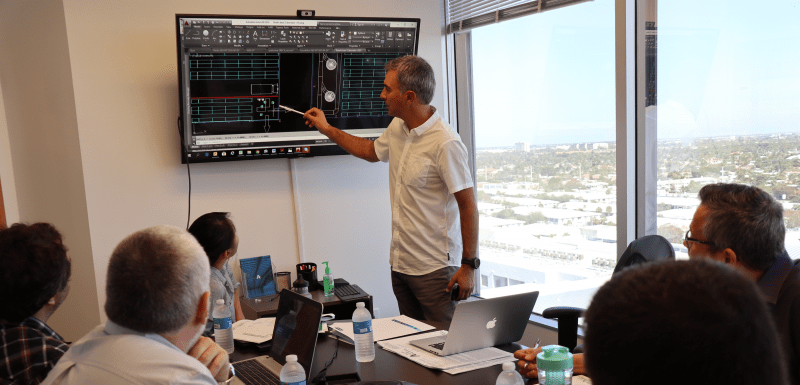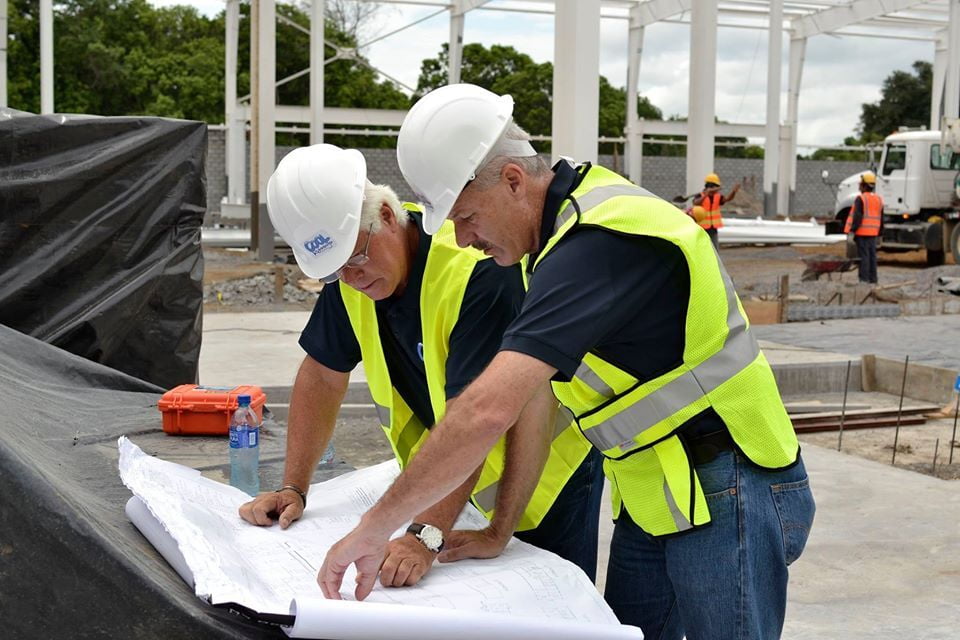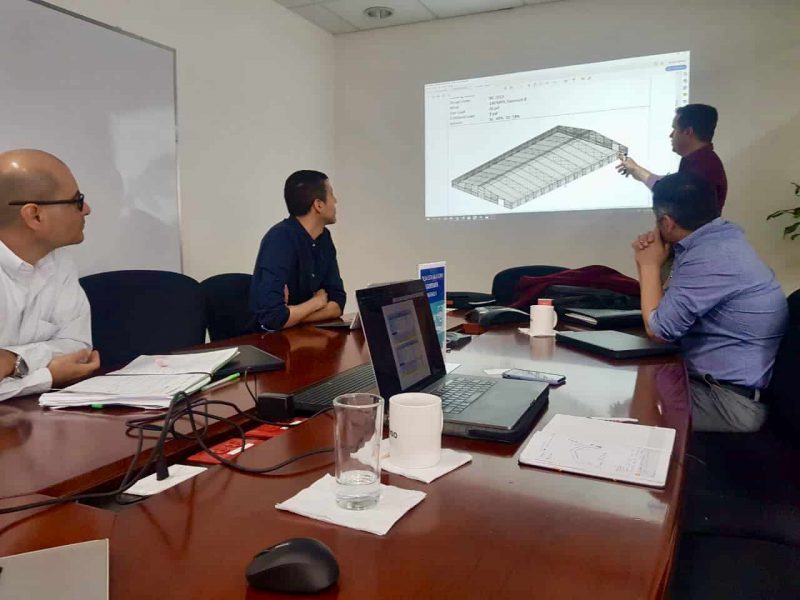Steel Building | Industrial Design-Build. As the industrial property market grows, sale and lease prices are continuing to skyrocket while the available inventory continues to dwindle. New construction, particularly Design-Build construction, is becoming an increasingly viable alternative for many businesses in the US that are looking to expand.
What is Design-Build Construction?
According to new research by the Design-Build Institute of America (DBIA), the growth of design-build construction has been stratospheric, with almost half of the construction projects in America being completed with this method over the last decade. Furthermore, this growth is predicted to continue at a rate of 18% through the next couple of years.
So, what’s Design-Build construction and why has it become so popular? To put it in a nutshell, Design-Build is an approach that combines different aspects and functions of a construction project into one streamlined process. A traditional construction approach requires a variety of separate contracts for services such as engineering, architecture, assessments, schematics, etc. With a design-build approach, however, all these services are incorporated into one single contract. One single entity (the Design-Builder) holds the responsibility, and is contractually liable, for all aspects of the build, ranging from the pre-construction to the post-construction phase to the project. This effectively ties up all stages of construction into one seamless process, providing the owners of the project with a single point of contact.
As the Design-Build approach combines all elements of a construction project, it allows the designers to effectively coordinate and collaborate with other teams involved in the project. In a traditional construction approach, the architectural design stage of a project is completed separately. However, with Design-Build, everyone on the project team is on the same page. This allows them to provide unified insight and recommendations with regards to the constructability and costs of various designs.
The Design-Build Process
When it comes to the Design-Build process, there are 5 main phases. These are:
- Choosing a Design-Builder
- Pre-construction evaluations and assessments
- Architectural design
- The construction phase
- The post-construction phase
Choosing a Design-Builder
While choosing an architect or designer is the first step of a traditional build approach, the Design-Build process commences when you decide on a Design-Builder.
As the main objective of Design-builders is to help you capture savings throughout the construction and design phase, it’ll be beneficial if you choose a Design-Builder based on qualifications. This means that you should opt for a Design-Builder that has the best combination of credentials, expertise and experience. Another viable method of choosing a Design-Builder is using a best-value selection approach. This involves considering added value and estimated price in addition to the credentials, experience and expertise of the candidates.
However, you should avoid a low-bid, hard-dollar approach when selecting a Design-Builder. Why? Well, Design-Builders provide optimum value by assessing budget solutions in the early part of the design phase, and by continuously creating cost estimates as the design advances. If you limit your pool of prospective Design-Builders to just hard-dollar bids before they’ve had an opportunity to get into the project, it can lead to uncertain and misleading estimates. An even worse scenario is you ending up with a project that doesn’t meet your requirements.
Pre-Construction: Incorporating High-Value Engineering into the Design
As it lays the groundwork for a successful job, the pre-construction phase is a crucial part of all construction projects. This also involves financial and business assessments, during which the Design-Builder’s pre-construction team gets to learn all about your enterprise, industry, vision, objectives, financial capacity and your current and future requirements from the project.
Concurrently, the engineering and architectural teams begin assessing mechanical, electrical and architectural systems and reviewing any existing structural systems, floor plans, emergency preparations and interior finishes. While vital information is being gathered by the design team, a field assessment of the build site is performed by the surveyors in order to get it ready for your project’s construction.
If you’re updating or improving your existing facility, the Design-Builder will perform an assessment of your facility to determine the areas of need. This will help define important parameters such as topography, local weather, compliance requirements, codes and more.
By combining all of this vital information with your organization’s budget, objectives and time constraints, your Design-Builder will provide a unified recommendation on the right construction and design program for your facility. Now that the crucial parameters of your project have been established, the next step is the architectural design process, where implementation of creative solutions begins and your vision finally starts taking shape.
Now that we’ve covered the pre-construction process, the next step is the architectural design phase.
Architectural Design Phase
The architectural design process presents the best opportunity to get the maximum value and cost-savings from the project. Architectural design is a lot more than just aesthetics and appearance. In fact, it’s a mixture of form and function where vision, strategy, technology and aesthetics combine to form a comprehensive design that makes your project a success.
When your project team reaches the architectural design phase, they already have a firm understanding of your enterprise, your financial capacity, the project schedule, construction site specifications and the engineering and architectural requirements of your facility. Next, the project managers from your construction team collaborate with those from your architectural team to evaluate cost-saving engineering solutions, or value engineering, that can be incorporated into the design.
This is where a Design-Build approach is different from other methods of construction. The Design-Builder can either hire the architects directly, or it can subcontract the design aspect of the project to a reputable architectural design firm. However, in both cases, the architects work with the Design-Builder under the same contract and on the same team. In a Design-Build approach, all the important project team members collaborate to come up with a design which balances all the requirements of the project. Engineers, architects, construction specialists and various important subcontractors can all contribute value at the initiation of the build.
The top Design-Builders use innovative digital construction modeling programs to enhance the speed and accuracy of the architectural design process. These technologies allow owners and stakeholders of the project to see how various design solutions can have an impact on the cost, appearance and schedule of the project. This helps owners make informed decisions with regards to setting the specifications for the projects, and provides cohesive certainty for the project team to move forward.

The Construction Phase
With a Design-Build construction approach, you won’t require a second bidding process to choose the right construction contractor. As a matter of fact, a Design-Build approach involves your job site being prepared, and elements of construction being readied, while the architectural design phase is still in progression. This signifies the time-saving benefit of having a Design-Builder. By overlapping design and construction work, your Design-Builder can aim for an aggressive project schedule. You still have a team of construction professionals, subcontractors and material providers, just like you would in a traditional construction approach. However, your project will be completed quicker and in a more organized manner.
The Post-Construction Phase
After the construction or renovation of your new facility has been completed, the next part is a post-construction handoff from your Design-Builder. This basically involves walkthroughs, core documentation, hands-on training sessions, instructional videos and more – essentially all things that will help the owners and facility managers to get the best out of the new facility. The post-construction handoff is a vital part of any construction project and as such, it shouldn’t be overlooked.

The Advantages of Design-Build
There’s a reason why Design-Build is such a popular construction method in the United States. A Design-Build approach offers a number of unique advantages that you simply don’t get with other methods of construction. Some of the major ones include a seamless process, faster delivery, better collaboration and better solutions.
Fast Delivery
As we touched upon in the section above, a Design-Build approach offers a faster delivery because it allows for construction and design work to happen simultaneously. Furthermore, a Design-build method only requires a single selection process, instead of the multiple ones required in a traditional method of construction. A Design-Build construction approach turns seemingly unachievable project schedules into a reality.
Seamless Process
By seamlessly combining all construction processes, Design-Build effectively eliminates headaches such as unforeseen costs and delays. Design-Build provides a single point of contact to owners. A single entity is responsible and accountable for all the different aspects of design and construction.
Better Value & Better Solutions
When it comes to Design-build, the solutions aren’t just limited to traditional construction strategies. The project itself is the boss, which means that the different project teams are free to try different ideas which will add value to the project. The different teams work as a solitary unit to evaluate and analyze all the ideas that are put on the table. Furthermore, there’s complete transparency, which gives owners the peace of mind that their project is getting the best site, design, materials, schedule and more. Design-Build is an approach which allows owners to evaluate more options, make better decisions and get a better value from their investment.
Smoother Communication & Fewer Problems
In order for a construction project to be successful, effective communication and open collaboration between the different teams is vital. Design-Build promotes a team-oriented, transparent approach of open communication which aligns the vision and objectives of all the stakeholders of the project.
As it puts all the teams involved with the project on the same page, a Design-Build approach facilitates the collaborative effort required to assess a project’s needs, analyze schedules and evaluate opportunities as work progresses.
The bottom line is that a Design-Build approach can effectively simplify even the most complex of construction projects while providing the owners with opportunities to realize better value from their investment.
Cost-Effective
Another great benefit of Design-build construction is its amazing cost-saving potential. Unlike general contracting projects, Design-build projects don’t include a hard-dollar bidding phase. However, as it’s more efficient than general contracting, Design-Build reduces both accounting costs and opportunity costs.
In many construction projects, the opportunity costs saved by Design-Build are much greater than real cost savings. As we’ve already discussed, one of the major benefits of a Design-Build approach is the amount of time it saves. And in the highly competitive business landscape, time equals money. The time saved by Design-Build can be invested in finding the solution to other pressing business concerns.
This specially applies to the construction of distribution or manufacturing industrial projects where the owner is attempting to expand productivity and operations. The sooner the construction of the facility is completed, the sooner the owner can increase production and, in turn, increase revenues. For some businesses, a delay of just a single day can cause them to lose hundreds of thousands of dollars in profits. This is where Design-Build’s speed of delivery becomes a crucial advantage.
Selecting the Right Design-Build Firm
While it does provide owners with a single-source responsibility, its one major drawback is the significant risk of having just a single entity holding responsibility of your entire project. When you opt for a Design-Build construction approach, the entire success of your project depends upon selecting the right Design-Build firm. Therefore, it’s vitally important that you choose a firm that has the right reputation and the experience. Here are some of the crucial characteristics to look for when evaluating Design-Build firms for your project.
Key Characteristics to Look for in a Design-Build Firm
When assessing potential choices in Design-Builders, opt for one that you can rely on as a partner. So, how exactly do you find such a firm? An ideal partner firm would be one that readily accepts a flexible contract and makes efforts to channel savings back to you.
Furthermore, the Design-builder you opt for should be able to present an extensive list of solid references and have a track-record of delivering successful projects that are similar to yours in nature.
And last, but perhaps most important, the Design-Builder you opt for should have an effective system of communication in place so that you and the other stakeholders are regularly updated on the project’s progress.

